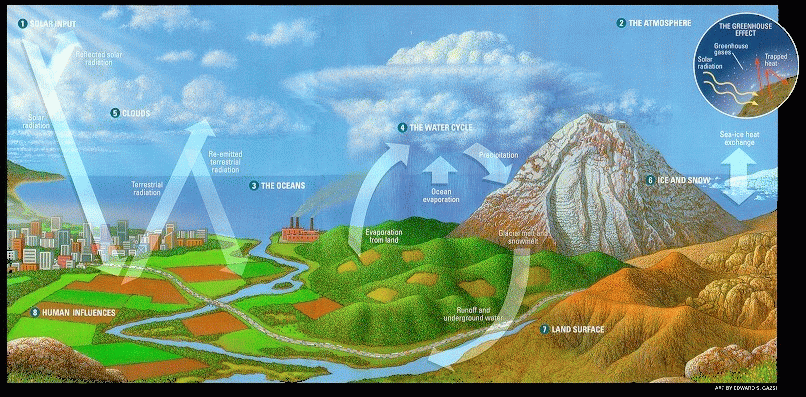
Weather is what happens outside your home this morning. Climate is what you can expect to happen outside during your 30-year mortgage. Over time small changes can make a big difference. Driven by tremendous flows of heat over the surface of the planet, Earth's climate system is influenced by innumerable interacting variables. Click on areas of the drawing below to find out more.

Back to Class Notes
Back to Class Notes
Back to Class Notes
Back to Class Notes
Back to Class Notes
Back to Class Notes
Back to Class Notes
Back to Class Notes
Back to Class Notes
Graphics and text from May 1998 National Geographic, Vol. 193, No. 5
1. Solar Input
Having traveled 93 million miles, solar energy hits the upper
atmosphere at about the intensity of three 100-watt bulbs per square
yard -- one-third of which is reflected back into space. The rest of
the energy warms Earth and fuels its weather engine.
Graphics and text from May 1998 National Geographic, Vol. 193, No. 5
2. The Atmosphere
A delicate balance of gases gives Earth an average temperature of 15
degrees Celsius (59F). Greenhouse gases -- water vapor, CO2, methane,
nitrous oxide, and others -- absorb heat energy, then re-radiate a
portion of it back to the surface.
Graphics and text from May 1998 National Geographic, Vol. 193, No. 5
3. The Oceans
Covering 70% of Earth's surface, oceans are the chief source of water
vapor in the air. Oceans store heat efficiently and transport it
thousands of miles. When warm water collects in one place,
evaporation and cloud buildup may increase. marine organisms consume
huge amounts of CO2.
Graphics and text from May 1998 National Geographic, Vol. 193, No. 5
4. The Water Cycle
Higher air temperatures can mean increased water evaporation and the
melting of sea and land ice. Although water vapor is the most potent
greenhouse gas, evaporation also leads to cloud formation, which can
have a cooling effect.
Graphics and text from May 1998 National Geographic, Vol. 193, No. 5
5. Clouds
The role of clouds is poorly understood, but they are known to both
cool Earth by reflecting solar energy and warm Earth by trapping heat
being radiated up from the surface.
Graphics and text from May 1998 National Geographic, Vol. 193, No. 5
6. Ice and Snow
Bright white expanses of ice and snow reflect sunlight back into
space, cooling the planet. Melting sea ice draws heat from the
ocean. In the Northern Hemisphere snow cover has decreased about 10%
in the past 21 years, but no significant melting of the Antarctic ice
sheet has been detected.
Graphics and text from May 1998 National Geographic, Vol. 193, No. 5
7. Land Surface
When solar energy penetrates the land surface it is converted into
heat, most of which radiates upward quickly. Still, topography and
land use can have major effects on climate. Mountain ranges can block
clouds, creating dry "shadows" downwind. Sloping land allows more
water runoff, leaving the land and air drier. A tropical forest will
soak up CO2, but once cleared for cattle ranching, the same land
becomes a source of methane.
Graphics and text from May 1998 National Geographic, Vol. 193, No. 5
8. Human Influences
Adding to the mix of greenhouse gases naturally present in the
atmosphere, human activities magnify warming effects. Fuel combustion
is the chief cause of rising CO2 concentrations. Ranching, rice
farming, and landfills have raised methane levels. Aerosols, such as
smoke and sulfate from industry, reflect sunlight and have temporary,
localized cooling effects.
Graphics and text from May 1998 National Geographic, Vol. 193, No. 5